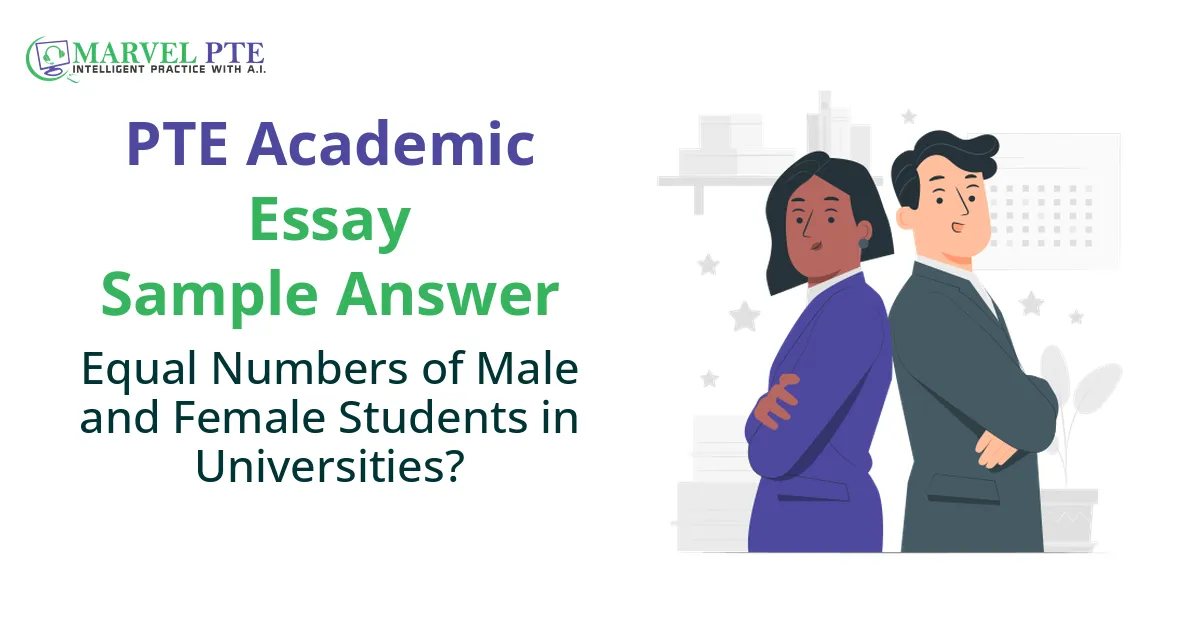
Essay Question
Universities should accept equal numbers of male and female students in every subject. To what extent do you agree or disagree?
90-Points (9 Bands) Sample Answer for Essay
The debate on whether universities accepting equal numbers of male and female students in every subject encompasses diverse viewpoints, revealing its advantages and drawbacks. This essay critically assesses these perspectives.
There are myriad arguments in favour of my stance. Recent research not only outlines the significance of studies as well as people, but also points out the importance of education and coping with vicissitudes. Besides, it provides a brief overview of expanding cultural understanding, followed by enhancing global perspectives. Examples of this can be seen all over the world, especially in affluent nations. Further, the implications of technological advancements on these views are significant, justifying widespread support for the idea that universities accepting equal numbers of male and female students in every subject.
However, there are some arguments against the aforementioned view. Besides, its impact is far-reaching indeed as its influence extends to various facets of society, shaping not only individual experiences but also impacting the academic research landscape. Therefore, it is apparent why many are against the notion that universities accepting equal numbers of male and female students in every subject.
In conclusion, while the viewpoint that universities accepting equal numbers of male and female students in every subject presents a complex array of advantages and disadvantages, my analysis leads me to firmly support the notion that its benefits substantially outweigh the drawbacks.
Warning! Important change in status after November 2024 update!*
Will I be able to score with this PTE Academic Essay Sample Answer?

You can confidently use this Essay Answer in the PTE Academic exam with similar results. You can even try it for yourself right now, click the link below and check immediately. Remember to type it all out, rather than copy pasting, as it will help you in getting prepared.
Template used in this Essay Sample Answer
You can also attempt to memorize the entire template before typing it. Here is the template for the AGBS essay type. There are two kinds of PTE essays: AGBS and PS. Both templates share a similar structure, with some variations in text to make the content more appropriate for the essay type.
Agree Disagree / Both Sides Template
The debate on whether TS* encompasses diverse viewpoints, revealing its advantages and drawbacks. This essay critically assesses these perspectives.
There are myriad arguments in favour of my stance. Recent research not only outlines the significance of studies as well as people, but also points out the importance of education and coping with vicissitudes. Besides, it provides a brief overview of expanding cultural understanding, followed by enhancing global perspectives. Examples of this can be seen all over the world, especially in affluent nations. Further, the implications of technological advancements on these views are significant, justifying widespread support for the idea that TS*.
However, there are some arguments against the aforementioned view. Besides, its impact is far-reaching indeed as its influence extends to various facets of society, shaping not only individual experiences but also impacting the academic research landscape. Therefore, it is apparent why many are against the notion that TS*.
In conclusion, while the viewpoint that TS* presents a complex array of advantages and disadvantages, my analysis leads me to firmly support the notion that its benefits substantially outweigh the drawbacks.
*Now, with the above template, you only have to add one phrase (a TS), which almost looks like a sentence.
What is TS?
A Topic Sentence (also known as TS) is an important part of a templated essay. It is a short sentence that states the main idea of the essay using words from the essay topic. The TS fits into a fixed structure where most of the content is already written. This sentence uses positive or neutral words only. A good TS avoids using pronouns and negations and tries to highlight the importance of the topic in context of the essay.
Example TS for the current essay:
'universities accepting equal numbers of male and female students in every subject'
What makes this TS suitable?
The TS "universities accepting equal numbers of male and female students in every subject" is fitting for the essay topic because it directly reflects the main idea of the prompt. The topic discusses the importance of universities admitting equal numbers of male and female students, and the TS clearly states this concept. It uses specific terms like "universities," "equal numbers," "male," and "female," which are essential to understanding the topic.
The TS presents a straightforward viewpoint that supports the idea of equality in university admissions. By focusing on the equality of male and female students, it sets the stage for discussing the implications of this approach. The sentence is grammatically correct and contains no spelling mistakes, which helps maintain clarity and professionalism in the writing.
Furthermore, the TS avoids unnecessary words and does not include pronouns or negative language, ensuring that the message remains clear and focused. It introduces the topic in a neutral manner, allowing for a balanced discussion on the extent to which this viewpoint can be agreed or disagreed with.
Overall, the TS effectively lays the groundwork for exploring the benefits and challenges of having equal admissions for male and female students in all subjects, making it a strong starting point for the essay.
Important Words for Relevancy + Content Scores
A TS needs to include words that are related to the essay topic, and here is a list of such words and phrases you can use to create your own TS. All of these are directly connected to the essay prompt, giving you several ideas for crafting your TS.
- Universities: Universities are higher education institutions that provide degrees and training in various subjects. For example, universities offer courses in science, arts, and technology, preparing students for their future careers.
- Equal Numbers: Equal numbers refer to having the same amount of something. For instance, universities may aim for equal numbers of male and female students to promote diversity and fairness in education.
- Male Students: Male students are boys or young men who are enrolled in educational institutions. For example, a university may have a group of male students studying engineering or business.
- Female Students: Female students are girls or young women who attend educational institutions. For instance, female students might participate in science clubs or sports teams at their university.
- Subject: A subject is a specific area of study, like mathematics or history. For example, students choose subjects based on their interests and career goals, helping them specialise in their education.
- Idea: An idea is a thought or suggestion about something. For instance, the idea of equal representation in universities encourages a balanced learning environment for all students.
- Offers: Offers refer to the opportunities or programmes provided by institutions. For example, universities offer scholarships to help students with their tuition fees.
- Gaming: Gaming refers to playing video games, often for fun or competition. For instance, many universities have gaming clubs where students can play together and participate in tournaments.
- Ideas Offering Growth: Ideas offering growth are concepts that can lead to personal or community development. For example, universities promote ideas that encourage innovation and critical thinking among students.
- Healthy Society: A healthy society is one where individuals thrive in well-being and harmony. For example, promoting education equality contributes to a healthy society by ensuring everyone has the chance to succeed.
- Enrolling: Enrolling means signing up or registering for a course or programme. For instance, students enrolling in university courses are taking the first step towards their higher education journey.
- Studying: Studying is the act of learning or reviewing information to gain knowledge. For example, students spend hours studying for exams to prepare for their future careers.
- Males: Males refer to the male gender, including boys and men. For instance, males in a university might study various subjects, contributing to the diversity of the student body.
- Females: Females refer to the female gender, including girls and women. For example, females in universities often pursue degrees in fields like healthcare, education, and the arts.
- Pupils: Pupils are students, especially in primary or secondary education. For instance, pupils in a school learn foundational skills that prepare them for further education in universities.
- Education: Education is the process of receiving or giving systematic instruction, especially at a school or university. For example, education helps individuals develop skills and knowledge for their future careers.
- Equality: Equality means treating everyone the same and giving them the same opportunities. For example, promoting equality in education ensures that all students, regardless of gender, have access to the same resources and support.
Attempt to create your own TS using these suggested words. Then fill in the above-mentioned template and submit it to our AI for evaluation. Keep making changes only in the TS until you achieve full scores. This is the fastest way for you to prepare for the writing section of the PTE Academic test.
Related Questions
- Who Should Address Climate Change Responsibilities?
- Do Celebrities Lose Their Right to Privacy?
- Is Parenting Important for Children?
- Extra Classes or Playtime for Children?
- Studying Films vs. Literature in School
- Should Voting Be Compulsory?
- How Has Communication Changed in the Last Decade?
- Work-Life Balance Challenges
- Importance of Life Values and Ethics in Learning
- Is Clean Energy Possible or Not?
